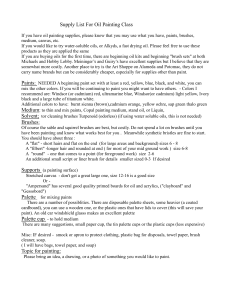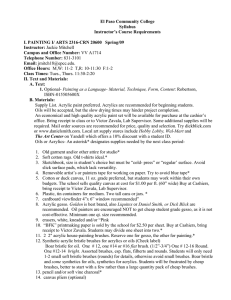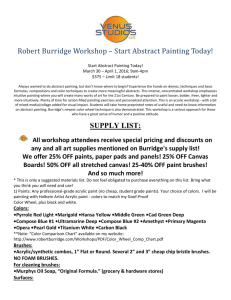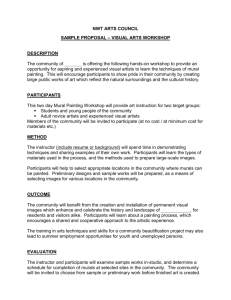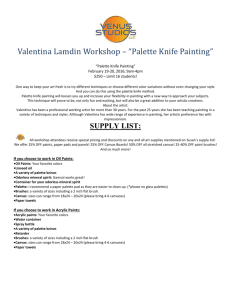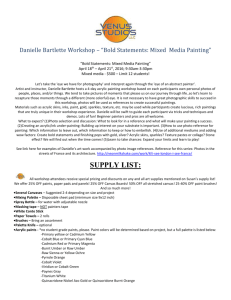Syllabus - Angelina College
advertisement
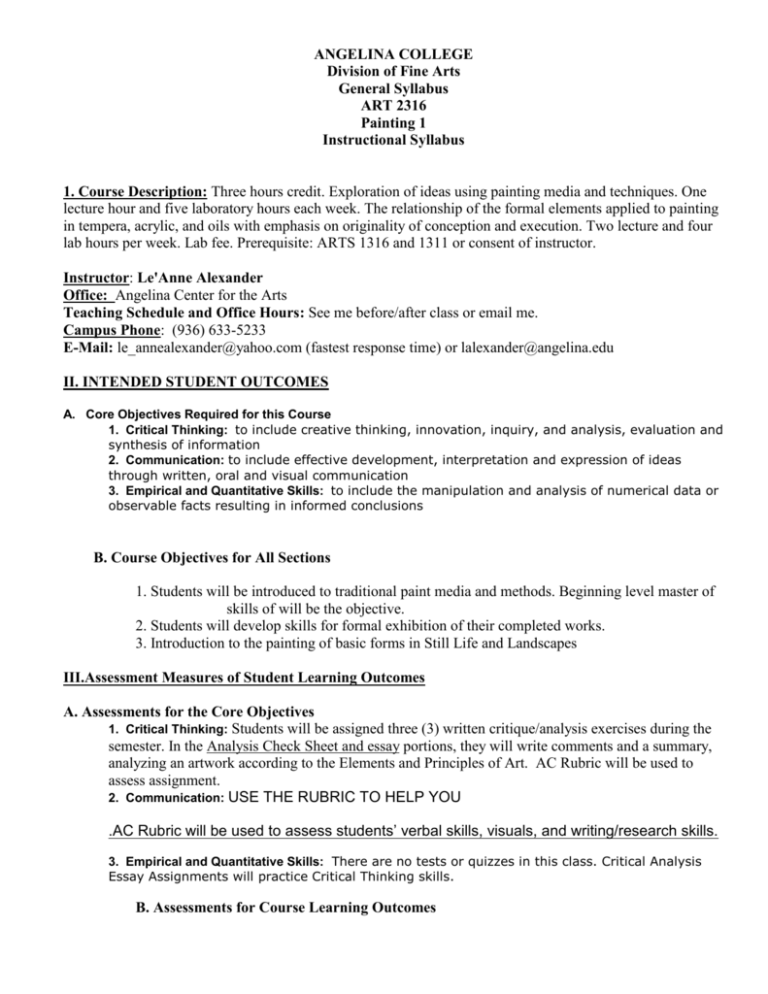
ANGELINA COLLEGE Division of Fine Arts General Syllabus ART 2316 Painting 1 Instructional Syllabus 1. Course Description: Three hours credit. Exploration of ideas using painting media and techniques. One lecture hour and five laboratory hours each week. The relationship of the formal elements applied to painting in tempera, acrylic, and oils with emphasis on originality of conception and execution. Two lecture and four lab hours per week. Lab fee. Prerequisite: ARTS 1316 and 1311 or consent of instructor. Instructor: Le'Anne Alexander Office: Angelina Center for the Arts Teaching Schedule and Office Hours: See me before/after class or email me. Campus Phone: (936) 633-5233 E-Mail: le_annealexander@yahoo.com (fastest response time) or lalexander@angelina.edu II. INTENDED STUDENT OUTCOMES A. Core Objectives Required for this Course 1. Critical Thinking: to include creative thinking, innovation, inquiry, and analysis, evaluation and synthesis of information 2. Communication: to include effective development, interpretation and expression of ideas through written, oral and visual communication 3. Empirical and Quantitative Skills: to include the manipulation and analysis of numerical data or observable facts resulting in informed conclusions B. Course Objectives for All Sections 1. Students will be introduced to traditional paint media and methods. Beginning level master of skills of will be the objective. 2. Students will develop skills for formal exhibition of their completed works. 3. Introduction to the painting of basic forms in Still Life and Landscapes III.Assessment Measures of Student Learning Outcomes A. Assessments for the Core Objectives 1. Critical Thinking: Students will be assigned three (3) written critique/analysis exercises during the semester. In the Analysis Check Sheet and essay portions, they will write comments and a summary, analyzing an artwork according to the Elements and Principles of Art. AC Rubric will be used to assess assignment. 2. Communication: USE THE RUBRIC TO HELP YOU .AC Rubric will be used to assess students’ verbal skills, visuals, and writing/research skills. 3. Empirical and Quantitative Skills: There are no tests or quizzes in this class. Critical Analysis Essay Assignments will practice Critical Thinking skills. B. Assessments for Course Learning Outcomes IV. Instructional Procedures A. Instructional Procedures 1. Demonstration of technique, One-on One instruction and ongoing Critiques of works in progress will constitute the primary presentation of the course. 2. Library, internet and other sources will accompany textbook reading assignments. Power Point, CD and/or video programs will augment lecture. Student participation in classroom discussion will be required. V. Course Requirements and Policies A. Text and Materials: NO TEXT. Specified reading and handouts as assigned. SEE SUPPLY LIST ATTACHED. 1. Critical analysis of artworks according to the Elements and Principles of Art will be a regular exercise. Visits to local and area art museums will be a required part of instruction. B. Assignments and Tests: Exercises done in class and assigned as homework will be expected on time as assigned. It is not the instructor’s policy to accept late work. Power point presentations and lectures will accompany some units. Primary sources, such as visiting artists will provide additional instruction when possible. 1. A short term paper will be assigned early on in the semester. Ample time will be given for the completion of this paper. 2. SEE ATTACHED CRITICAL ANALYSIS ASSIGNMENTS FOR THIS SEMESTER. C. COURSE POLICIES Academic Assistance: If you have a disability (as cited in Section 504 of the Rehabilitation Act of 1973 or Title II of the Americans with Disabilities Act of 1990) that may affect your participation in this class, you must self-identify as a person with a disability; Ms. Bower will assist you with the necessary information to do so. To report any complaints of discrimination related to disability, you should contact Dr. Patricia McKenzie, Administration Building, Room 105 or 936-633-5201. This course meets twice weekly. Assignments are to be turned in on specified due dates. No late work will be accepted except under appropriate circumstances, such as excused absence or emergency. Punctual, regular attendance is mandatory. Leaving early from class will constitute an absence. DROP POLICY - A student may be dropped by the instructor for disruptive behavior, WHICH INCLUDES USING ELECTRONICS IN CLASS, ENTERING CLASSROOM LATE THEREBY INTERRUPTING INSTRUCTION, INAPPROPRIATE DRESS, OR OTHER ACTIONS THAT DISTRACT STUDENTS OR INSTRUCTOR FROM CLASS PROCEDURES. A student will be dropped after three consecutive absences or four cumulative absences. Three tardies constitute an absence. If a student determines not to continue the course, the normal procedures for dropping a course must be instituted and followed by the student. Failure to drop a course may result in a grade of “WF” which, for purposes of the student’s records, is a grade of “F”. It is the student’s responsibility to contact the instructor prior to any absence that may be considered excusable due to reasonable circumstances. Incompletes will be granted only in emergency situations and will require approval of the Dean of Instruction and Admissions. Two unexcused absences after the final Withdraw date will result in the student’s final grade being lowered a full letter grade. Three or more unexcused absences after the final Withdraw date will result in a final grade of “F”. VI. Course Content The need for flexibility demands that dates not be specified for the completion of a given unit. Students must have reached a certain level of mastery to move on to the next level of study. Units of Study A. Paints, Brushes and Supports (ongoing) B. Demonstrations in Acrylics (ongoing) C. Study in Black and White (on paper) D. Monochromatic Study - Theories of light and dark in painting from life (on paper) E. Tri-color Palette study of Traditional Subject Matter (on provided stretchers) 1. Still Life or Floral 2. Landscape F. Full color Palette - Self-portrait (on student made stretchers) G. Painting from a Photo - Full Color Palette (on panel) H. One-On-One Instruction - Student Choice of Subject and Palette I. Expressive Painting, Mixed Media J. Final Portfolio K. Ongoing Evaluation of Application of Technique L. Exhibition of artwork in professional gallery space (AC Gallery) VII. Grading A. Grading Criteria For Studio Projects, each artwork will be labeled with an evaluation label, specifically outlining the formula used in grading the artwork. A copy of this label is available from the instructor upon request. Grades will be averaged as follows: A = 90 - 100 A+ = 100 A- = 90 - 93 B = 80 - 89 B+ = 89 B- = 80 - 83 C = 70 - 79 C+ = 79 C- = 70 - 73 D = 60 - 69 D+ = 69 D - = 60 - 63 F = 1 – 59 B. Determination of Grade 60% = Average of in-class work habits, improvement & finished paintings in portfolio reviews 30% = Average of Written Assignments 10% = Final Portfolio Review VIII. SYLLABUS MODIFICATION The Instructor may modify the provisions of the syllabus to meet individual class needs by informing the class in advance as to the changes being made. IX. SAFETY PRECAUTIONS ·Students are expected to adhere to school policy in relation to all safety issues and rules regarding paint on campus. Aerosols, fixatives, spray paints may only be used within ventilation booths or outside ·Solvents and all flammable materials must be disposed of in the designated red containers within the classroom. ·Students should restrict their supplies as much as possible to only odorless, non-toxic mediums. ·Paint should not ever be washed off into the sink. Clean your brushes first with paper towels and dispose of them properly, then rinse brushes in solvent and water, and finally use the sink only for the last step of using soap on the brushes. ·Students must show respect at all times for others working within the space, whether it be instructors, students or visitors. ·If student has a concern about a material, he or she is advised to ask the instructor first before bringing it into the studio. If there is a problem, the instructor will let you know. ·No food or drink allowed in the painting studio. Students are also advised to wash their hands before any smoke breaks or lunch breaks that may take place outside of the room. 1. CELL PHONES: Please only have you cell phone out if you are using it for your headphones. Music is allowed while working as long as it doesn't disrupt other students or instructor. If you must take an emergency call during work time, please step outside to answer so that you are not a distraction to the class. X. SUPPLIES LIST: Paints: 1. Set of Acrylic Paints including: Mars Black Titanium White Napthol Red Phthalo Green CadmiumYellow Ultramarine Blue Alizarin Crimson You may buy them by set or individually, whichever way works for you. I recommend Golden Acrylics, as these are the best quality but are expensive and must be ordered. Next in superiority is Liquitex, then the rest of them are about equal. If you are on a budget, you may work with the lowest student grade/Hobby Lobby brand (Fine Touch Acrylics) Do not get the small 5 oz craft acrylic bottles. You may end up buying another Titanium White by the end of the semester, so consider a larger bottle. 2. A bottle of Acrylic Gloss Gel Medium to extend your paint quantity any brand will do 3. Toward the middle of the semester, you'll need a small bottle each of Yellow Ochre, Burnt Sienna, & Cobalt Blue (small bottles are half the size and cost) Brushes: 1. A variety of sizes and shapes: Round, Flat, Filbert (Labeled for Acrylics, not for watercolor or oil only) 2. A 1 inch wood handle brush (Dollar tree or Lowes) 3. A set of black foam brushes (Dollar tree) 4. A large black plastic industrial painting brush for gesso. (Dollar tree or Lowes) Supports: (Canvas, Stretchers and Paper will be provided for you, but 2 supports must be made by you. This is integral to this class being transferrable to 4-yr schools.) You must come to each class with the materials ready to build your supports. You will be warned in advance of when to have them by. 1. Canvas Stretcher Supplies: five 1 x 2s any length Lattice board (pine) NOT THE FENCING LATTICE 2. Panel Supplies: one 24" x 24" sheet of 1/4 in Birch Plywood (Lowes or Home Depot) you may also use masonite if you can find it in a 24" x 24", but it isn't preferable. four 24" 1 x 2s Palette: Anything that works for you. Cheapest way out is a roll of wax paper, also there are books of disposable palettes you can purchase. Another option would be a tupperware container with lid. These can help you not waste paint by keeping them air tight. Don't get the little plastic circle ones. A bucket for cleaning your brushes and keeping them wet. A spray bottle (optional) A roll of paper towels An apron An old rag Murphy's Oil soap Gloves (optional unless you are pregnant, then get the blue latex-free Nitrile gloves) A container to keep all this in. A toolbox works great. You'll have a locker to store them in between classes. Please do your best to save money on supplies in any way you can, but do not scrimp on the quality of the brushes. The cheaper they are, the more amateur the work will end up looking.
